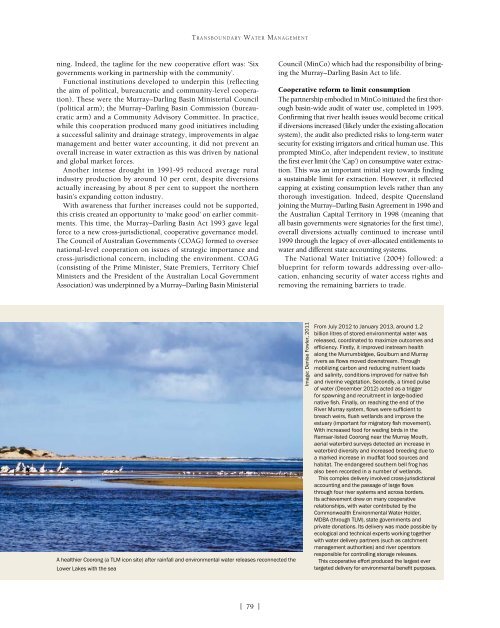222893e
222893e
222893e
Create successful ePaper yourself
Turn your PDF publications into a flip-book with our unique Google optimized e-Paper software.
TRANSBOUNDARY WATER MANAGEMENTning. Indeed, the tagline for the new cooperative effort was: ‘Sixgovernments working in partnership with the community’.Functional institutions developed to underpin this (reflectingthe aim of political, bureaucratic and community-level cooperation).These were the Murray–Darling Basin Ministerial Council(political arm); the Murray–Darling Basin Commission (bureaucraticarm) and a Community Advisory Committee. In practice,while this cooperation produced many good initiatives includinga successful salinity and drainage strategy, improvements in algaemanagement and better water accounting, it did not prevent anoverall increase in water extraction as this was driven by nationaland global market forces.Another intense drought in 1991-95 reduced average ruralindustry production by around 10 per cent, despite diversionsactually increasing by about 8 per cent to support the northernbasin’s expanding cotton industry.With awareness that further increases could not be supported,this crisis created an opportunity to ‘make good’ on earlier commitments.This time, the Murray–Darling Basin Act 1993 gave legalforce to a new cross-jurisdictional, cooperative governance model.The Council of Australian Governments (COAG) formed to overseenational-level cooperation on issues of strategic importance andcross-jurisdictional concern, including the environment. COAG(consisting of the Prime Minister, State Premiers, Territory ChiefMinisters and the President of the Australian Local GovernmentAssociation) was underpinned by a Murray–Darling Basin MinisterialCouncil (MinCo) which had the responsibility of bringingthe Murray–Darling Basin Act to life.Cooperative reform to limit consumptionThe partnership embodied in MinCo initiated the first thoroughbasin-wide audit of water use, completed in 1995.Confirming that river health issues would become criticalif diversions increased (likely under the existing allocationsystem), the audit also predicted risks to long-term watersecurity for existing irrigators and critical human use. Thisprompted MinCo, after independent review, to institutethe first ever limit (the ‘Cap’) on consumptive water extraction.This was an important initial step towards findinga sustainable limit for extraction. However, it reflectedcapping at existing consumption levels rather than anythorough investigation. Indeed, despite Queenslandjoining the Murray–Darling Basin Agreement in 1996 andthe Australian Capital Territory in 1998 (meaning thatall basin governments were signatories for the first time),overall diversions actually continued to increase until1999 through the legacy of over-allocated entitlements towater and different state accounting systems.The National Water Initiative (2004) followed: ablueprint for reform towards addressing over-allocation,enhancing security of water access rights andremoving the remaining barriers to trade.A healthier Coorong (a TLM icon site) after rainfall and environmental water releases reconnected theLower Lakes with the seaImage: Denise Fowler, 2011From July 2012 to January 2013, around 1.2billion litres of stored environmental water wasreleased, coordinated to maximize outcomes andefficiency. Firstly, it improved instream healthalong the Murrumbidgee, Goulburn and Murrayrivers as flows moved downstream. Throughmobilizing carbon and reducing nutrient loadsand salinity, conditions improved for native fishand riverine vegetation. Secondly, a timed pulseof water (December 2012) acted as a triggerfor spawning and recruitment in large-bodiednative fish. Finally, on reaching the end of theRiver Murray system, flows were sufficient tobreach weirs, flush wetlands and improve theestuary (important for migratory fish movement).With increased food for wading birds in theRamsar-listed Coorong near the Murray Mouth,aerial waterbird surveys detected an increase inwaterbird diversity and increased breeding due toa marked increase in mudflat food sources andhabitat. The endangered southern bell frog hasalso been recorded in a number of wetlands.This complex delivery involved cross-jurisdictionalaccounting and the passage of large flowsthrough four river systems and across borders.Its achievement drew on many cooperativerelationships, with water contributed by theCommonwealth Environmental Water Holder,MDBA (through TLM), state governments andprivate donations. Its delivery was made possible byecological and technical experts working togetherwith water delivery partners (such as catchmentmanagement authorities) and river operatorsresponsible for controlling storage releases.This cooperative effort produced the largest evertargeted delivery for environmental benefit purposes.[ 79 ]


